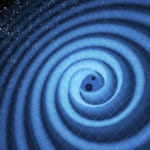Gravitational waves and other surprises that the universe holds in store
Gravitational waves have been the most-talked-about scientific discovery of the year that is about to conclude. David Reitze, the physician that broke the news to the world, describes it as an achievement that can be compared to measuring the distance from our Sun to the nearest star with a margin of error under a human hair’s breadth.

The first wave detected was produced the merger of two black holes located some 1.3 billion light years away from Earth, which had been spiraling around each other for several million years, accelerating as they drew nearer. When they finally merged into a single massive black hole, they unleashed a violent storm in the space-time that has rippled its way all across the universe, to reach us in the form of a slight tremor.
David Reitze, who visited Madrid to deliver a speech at BBVA Foundation, is the executive director of LIGO, the observatory that, on September 14, 2015, detected the vibrations caused by the merger of the black holes.
Einstein, who predicted the existence of these phenomena 100 years ago, thought that gravitational waves would never be detected
He recalled how, 20 years ago, when he was offered the opportunity to join the LIGO team, many “thought that gravitational waves would never be detected.” Albert Einstein, who predicted the existence of these phenomena 100 years ago, was just as skeptical. Today, this discovery is the top candidate to take next year’s Nobel Prize in Physics.

David Reitze announcing that scientists have observed gravitational waves for the first time. - NSF
It was Reize himself who, on February 11th this year, officially announced that the LIGO Scientific Collaboration had detected one of the eagerly awaited waves, after confirming the validity of the signals sensed a few months before. In a crowded press conference organized by the U.S. National Science Foundation, Reitze said: “Ladies and gentlemen, we have detected gravitational waves. We did it!.” The room broke into applause.
Proud, excited, a bit tired
Reitze’s immediately historic words hermetically sealed any doubts regarding the existence of objects so alien to our everyday lives such as a black hole, and also over the power of Einstein’s General Relativity Theory to describe the universe. This theory holds that space and time interweave in the universe, forming a fabric that warps in the presence of matter; this warp is what we perceive as gravity.
The thousand scientists from fifteen countries that make up the LIGO Scientific Collaboration now feel “proud, excited, eager to welcome the future science of gravitational waves,” says Reitze. They are also, he confesses, “a bit tired, after all the excitement going on last year.”
Gravitational waves travel through space at the speed of light, stretching and squeezing the space-time. Without, as Reitze puts it, “the most sensitive instrument ever developed,” it would have been impossible to detect these vibrations. “It is an achievement that can be compared to measuring the distance from our Sun to the nearest star with a margin of error under a human hair’s breadth.”
Hearing the universe tremble
Up until now, most of the information that astrophysicists had access to, arrived in the shape of light emitted by astronomic objects (visible light, infrared light, x-rays, ultraviolet and gamma radiation, etc.) LIGO’s detection proves that it is also possible to listen to the tremors of space-time itself.

Simulated image of the two merging black holes detected by LIGO - SXS Project
This new sense is essential for studying phenomena and objects such as black holes, which do not emit light, and whose existence had only been inferred up until now through very solid - yet indirect - pieces of evidence.
For Reitze, this new sense will bring a “revolution" for astronomy. How far will it take us? “Only time will tell!” We have observed the merger of binary black holes, and in a not too distant future we hope to be able to see two neutron star colliding, and collisions between two neutron stars and a black hole. We may even be able to observe a galactic supernova, or an isolated neutron star. The highest reward would be observing the Big Bang, the birth of the universe, through gravitational waves. But this will require different types of detectors."
The history of science tells us, continues Reize, that each time we develop a new instrument, we discover things that nobody had anticipated using the scientific paradigms of their era. “I wouldn’t be surprised at all if the universe surprises us in ways we can’t even imagine!.”